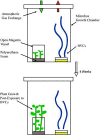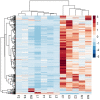Volatile Compounds From Bacillus, Serratia, and Pseudomonas Promote Growth and Alter the Transcriptional Landscape of Solanum tuberosum in a Passively Ventilated Growth System
- PMID: 34367077
- PMCID: PMC8333284
- DOI: 10.3389/fmicb.2021.628437
Volatile Compounds From Bacillus, Serratia, and Pseudomonas Promote Growth and Alter the Transcriptional Landscape of Solanum tuberosum in a Passively Ventilated Growth System
Abstract
The interaction of an array of volatile organic compounds (VOCs) termed bacterial volatile compounds (BVCs) with plants is now a major area of study under the umbrella of plant-microbe interactions. Many growth systems have been developed to determine the nature of these interactions in vitro. However, each of these systems have their benefits and drawbacks with respect to one another and can greatly influence the end-point interpretation of the BVC effect on plant physiology. To address the need for novel growth systems in BVC-plant interactions, our study investigated the use of a passively ventilated growth system, made possible via Microbox® growth chambers, to determine the effect of BVCs emitted by six bacterial isolates from the genera Bacillus, Serratia, and Pseudomonas. Solid-phase microextraction GC/MS was utilized to determine the BVC profile of each bacterial isolate when cultured in three different growth media each with varying carbon content. 66 BVCs were identified in total, with alcohols and alkanes being the most abundant. When cultured in tryptic soy broth, all six isolates were capable of producing 2,5-dimethylpyrazine, however BVC emission associated with this media were deemed to have negative effects on plant growth. The two remaining media types, namely Methyl Red-Voges Proskeur (MR-VP) and Murashige and Skoog (M + S), were selected for bacterial growth in co-cultivation experiments with Solanum tuberosum L. cv. 'Golden Wonder.' The BVC emissions of Bacillus and Serratia isolates cultured on MR-VP induced alterations in the transcriptional landscape of potato across all treatments with 956 significantly differentially expressed genes. This study has yielded interesting results which indicate that BVCs may not always broadly upregulate expression of defense genes and this may be due to choice of plant-bacteria co-cultivation apparatus, bacterial growth media and/or strain, or likely, a complex interaction between these factors. The multifactorial complexities of observed effects of BVCs on target organisms, while intensely studied in recent years, need to be further elucidated before the translation of lab to open-field applications can be fully realized.
Keywords: GC/MS; biocontrol; plant growth-promotion; plant-bacteria interactions; transcriptomics; volatile organic compounds.
Copyright © 2021 Heenan-Daly, Coughlan, Dillane and Doyle Prestwich.
Conflict of interest statement
The authors declare that the research was conducted in the absence of any commercial or financial relationships that could be construed as a potential conflict of interest.
Figures









Similar articles
-
Sweet scents from good bacteria: Case studies on bacterial volatile compounds for plant growth and immunity.Plant Mol Biol. 2016 Apr;90(6):677-87. doi: 10.1007/s11103-015-0344-8. Epub 2015 Jul 16. Plant Mol Biol. 2016. PMID: 26177913 Review.
-
Elicitation of Innate Immunity by a Bacterial Volatile 2-Nonanone at Levels below Detection Limit in Tomato Rhizosphere.Mol Cells. 2022 Jul 31;45(7):502-511. doi: 10.14348/molcells.2022.2009. Epub 2022 Jul 4. Mol Cells. 2022. PMID: 35791736 Free PMC article.
-
Soil bacterial diffusible and volatile organic compounds inhibit Phytophthora capsici and promote plant growth.Sci Total Environ. 2019 Nov 20;692:267-280. doi: 10.1016/j.scitotenv.2019.07.061. Epub 2019 Jul 5. Sci Total Environ. 2019. PMID: 31349168
-
Beyond the two compartments Petri-dish: optimising growth promotion and induced resistance in cucumber exposed to gaseous bacterial volatiles in a miniature greenhouse system.Plant Methods. 2019 Feb 2;15:9. doi: 10.1186/s13007-019-0395-y. eCollection 2019. Plant Methods. 2019. PMID: 30733821 Free PMC article.
-
Revisiting bacterial volatile-mediated plant growth promotion: lessons from the past and objectives for the future.Ann Bot. 2018 Aug 27;122(3):349-358. doi: 10.1093/aob/mcy108. Ann Bot. 2018. PMID: 29982345 Free PMC article. Review.
Cited by
-
Drought-Alleviating Effects of Endophytic Bacteria Isolated from Xerophytic Plants on Capsicum annuum L. Seedlings.Curr Microbiol. 2023 Nov 6;80(12):403. doi: 10.1007/s00284-023-03494-8. Curr Microbiol. 2023. PMID: 37930407
-
Identification and Surveys of Promoting Plant Growth VOCs from Biocontrol Bacteria Paenibacillus peoriae GXUN15128.Microbiol Spectr. 2023 Jun 15;11(3):e0434622. doi: 10.1128/spectrum.04346-22. Epub 2023 Mar 29. Microbiol Spectr. 2023. PMID: 36988498 Free PMC article.
-
Bacterial volatile organic compounds (VOCs) promote growth and induce metabolic changes in rice.Front Plant Sci. 2023 Feb 9;13:1056082. doi: 10.3389/fpls.2022.1056082. eCollection 2022. Front Plant Sci. 2023. PMID: 36844905 Free PMC article.
-
Antifungal Activity and Alleviation of Salt Stress by Volatile Organic Compounds of Native Pseudomonas Obtained from Mentha piperita.Plants (Basel). 2023 Mar 29;12(7):1488. doi: 10.3390/plants12071488. Plants (Basel). 2023. PMID: 37050113 Free PMC article.
-
Biological control potential of worrisome wheat blast disease by the seed endophytic bacilli.Front Microbiol. 2024 Mar 11;15:1336515. doi: 10.3389/fmicb.2024.1336515. eCollection 2024. Front Microbiol. 2024. PMID: 38529179 Free PMC article.
References
-
- Abarca R. L., Rodríguez F. J., Guarda A., Galotto M. J., Bruna J. E., Perez M. A. F., et al. (2017). Application of β-cyclodextrin/2-nonanone inclusion complex as active agent to design of antimicrobial packaging films for control of Botrytis cinerea. Food Bioproc. Technol. 10 1585–1594. 10.1007/s11947-017-1926-z - DOI
LinkOut - more resources
Full Text Sources
Molecular Biology Databases
Miscellaneous

